Dog Food
Freshly delivered, exclusively on subscription.
Join over 40,000 Aussie dogs!
Try Scratch FoodTreats and extras
Premium dog essentials and 100% natural treats for a happy pup and a happy home.
Shop ExtrasThe Rescue Dog Guide
The best thing about rescuing a dog is that you’re giving an animal a second chance. But rescuing a dog often takes a lot of time: depending on their past, rescue dogs may have behavioural issues or habits they need extra training and support to deal with.
This dog rescue guide will help you to make a responsible decision and be prepared to give them an amazing second chance.

Introduction to getting a rescue dog
There are lots of things to consider before you jump in and adopt a dog. So before you commit, ask yourself these questions.
Do You Have Time?
Getting a dog—whether a rescue or not—requires a substantial time commitment. You should consider taking a week off work to help them settle into their new home. If they’re a puppy, expect your sleep to be disrupted for a couple of months too.
Across their life they’ll need a lot of walking, training, grooming and play time. We’ve bred dogs to love spending time with us. Think about how long you’d be away from them each day. Do you go on lots of holidays? Is your workplace dog-friendly? Remember: this is a long-term commitment. It’s not fair to commit to dog rescue if they’ll always be alone.
Have You Considered Cost?
Rescue dogs usually have lower adoption fees than designer or pure breeds. But remember, that’s just the purchase price. It doesn’t include vets, collars, leads, beds, toys, treats, food, training or anything else you’ll want to treat your pup with. Ongoing costs will vary but the expenses add up fast. Especially if your dog has health problems, accidents or emergencies. Many people choose to get pet insurance to reduce this impact.
Do You Love Homework?
It’s vital you learn about caring for a dog before you get one. This is particularly true for rescues who can require more support and may benefit from seeing a behaviourist or trainer. It’s easier to train a dog from the start than to inadvertently teach the wrong behaviour and then have to correct it. If you haven’t been the primary adult carer for a dog before you should get reading.
Is Your House Ready?
Make sure your home is suitable for a dog and remember that different breeds will have different needs. Consider the pet’s size, your property type, security of outside areas and dangerous items you may have lying around. If you want a pristine home, probably get a goldfish instead.
Are You Picky or in a Rush to Adopt a Dog?
It can take time to find a rescue dog that suits you and your lifestyle. Adoption is often competitive and may take months. Additionally, you have less choice when it comes to breed and age. If you have your heart set on a specific kind of dog, you might be waiting for a long time.
Where to adopt rescue dogs
Adopting a rescue dog is a rewarding process, but it can also be a long one. Unlike adopting from a breeder, there are no waiting lists you can join to help you find the perfect pet. Rescue dogs come from many places: shelters, breed groups, family and friends or even the street.
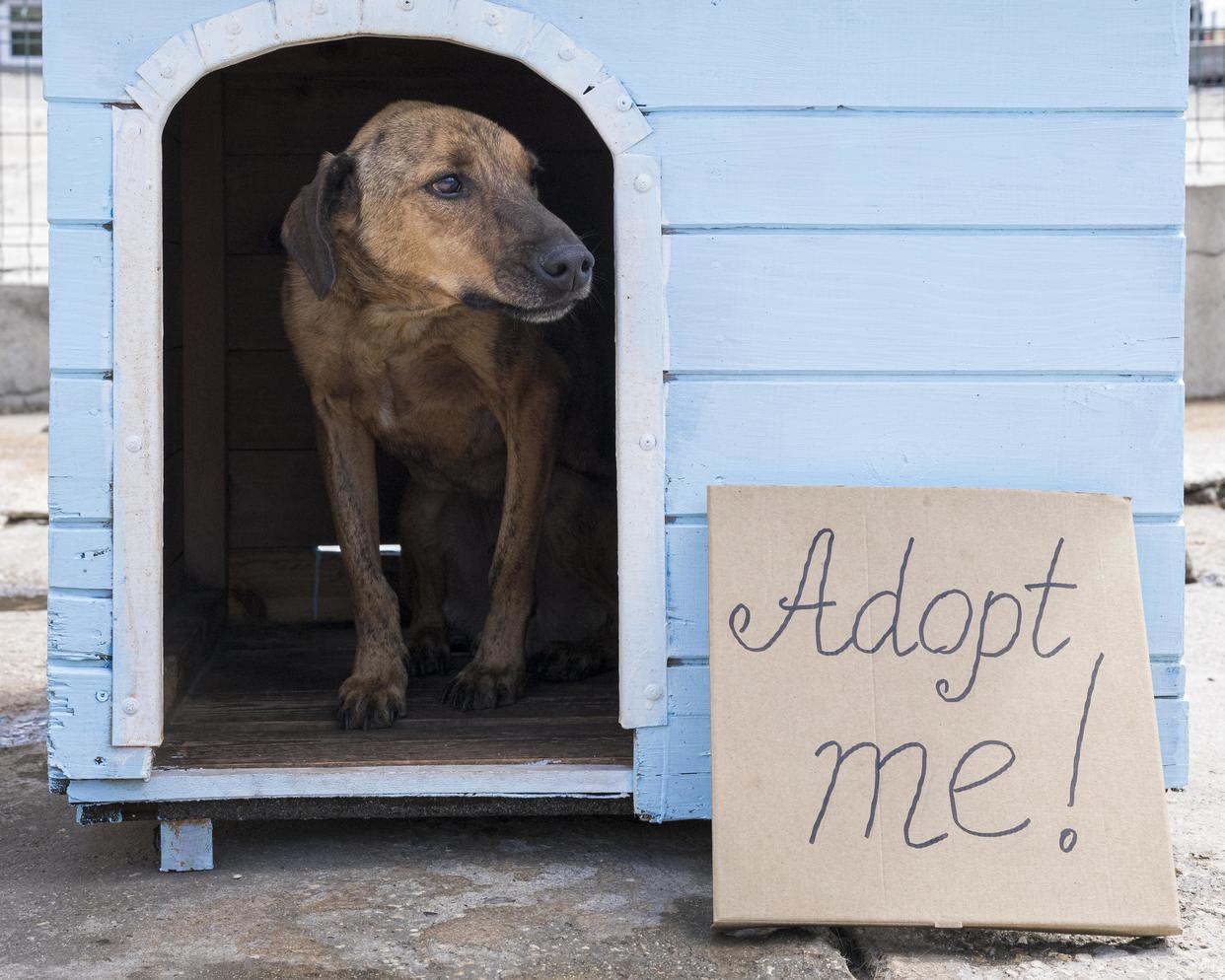
Animal Rescue Shelters
Shelters are run by large government or non-profit organisations, and employ a team to look after the animals’ needs. Reputable shelters spend time getting to know a dog, monitoring their behaviour and health, before deciding they’re ready to go home with someone. They do this to identify issues, such as aggression, that could cause problems.
A responsible shelter will ask you a lot of questions about your experience with animals and living situation to ensure you’re ready to adopt a dog. Be weary of any organisation that doesn’t put you through your paces or feels like they’re pushing you to make a commitment.
Support from shelters should extend beyond adoption. They can serve as a good resource to help manage your pet’s training, health and behaviour.
Adopting a dog from an animal shelter can be competitive. Smaller and younger animals tend to be adopted quickly. It’s not unusual for it to take months to find the right dog, so be patient!
Independent Rescue Groups
Independent rescue groups often focus on specific breeds that need to be rehomed. They’re usually run by small teams of dog lovers who help out animals in their spare time. Like shelters they can be a great, trusted place to find a dog. Also, being smaller than shelters, there can be less competition and they may be more open to organising interstate adoptions. But this also means they could have less resources for training and vetting animals in their care, as well as checking you’re a good match for them. While many offer ongoing support, they’re usually not able to do so at the same level as larger rescue centres.
Online
Rescue dogs regularly appear in online spaces like Gumtree and Facebook. These are mostly one off adoptions where an owner can’t manage their pet anymore. Adopting from these largely unregulated spaces can feel like you’re helping an animal in need. But it’s better for them to be taken to an official rescue centre where their physical and emotional state can be assessed. Ongoing support or personal vetting can’t be offered in these adoptions, meaning you may end up with a dog you can’t manage or who wasn’t ready to join a family.
Through Family and Friends
Many rescue dog adoptions aren’t planned. Rather people take in an animal when a friend or family member is no longer able to look after them. If you know a dog well and can spend time with them before they move in, it can be a nice way to support them and offer a stable home. But even if you’re familiar with an animal, there may be issues. The most well-adjusted dogs can develop anxiety and behavioural issues during big changes. It’s important to treat a rescue you’re familiar with, with as much care as one you just met. Go through the steps in this guide, and consider speaking to your vet or a dog behaviorist if they exhibit signs of distress. Don’t assume they’ll be fine because they haven’t previously had issues.
In General
Wherever you choose to adopt your dog from, it’s important to do your homework and make sure they’re reputable. This means visiting the space, speaking to people who have adopted from there, and checking reviews and articles about them online.
Signs of a good organisation include: detailed knowledge of dog health and behaviour, offering ongoing support and training, allowing you to return the dog if there are issues, and a detailed adoption process where they ask you a lot of questions to ensure you’re suitable. Trust your gut, if something feels off find another place to adopt from.
How to choose the right rescue dog
With advice from Bark in the Park dog trainer Megan Hayes.
Giving a dog a second chance at life is a super rewarding process, but how do you pick the perfect rescue dog? Here are a few things to consider to help you meet your match.
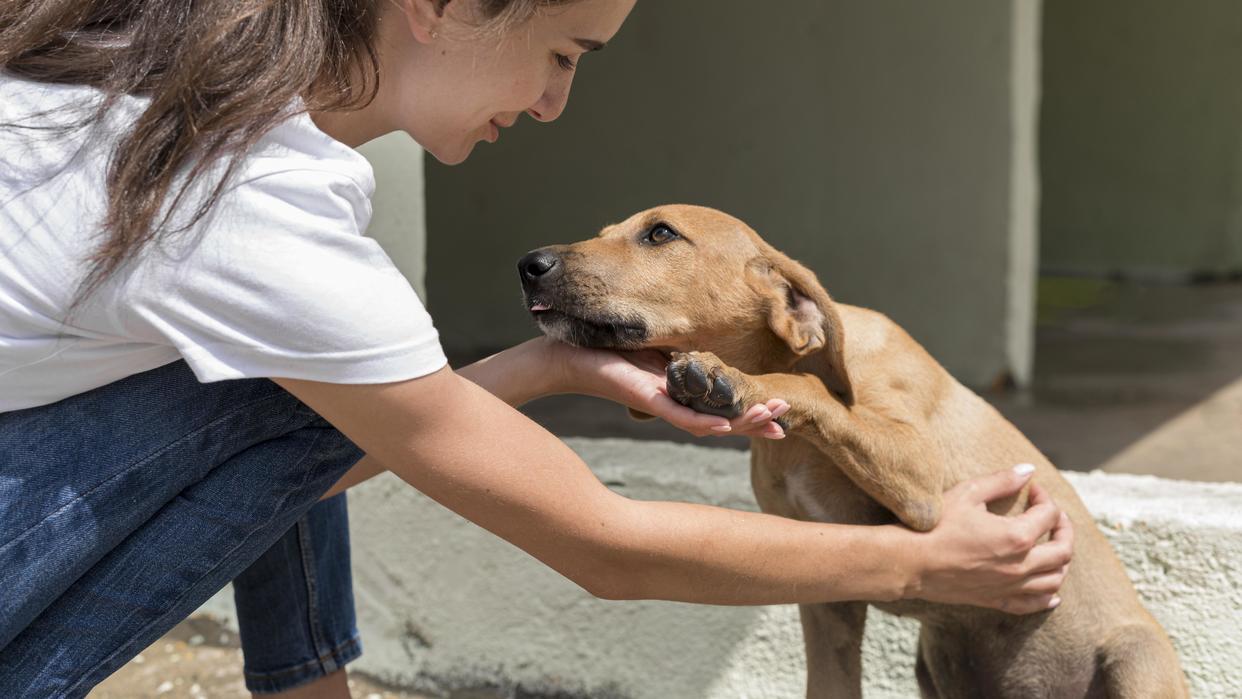
Step 1: Figure out What Type of Companion You’re Looking For
Prior to searching for a rescue dog, consider what kind of environment and care you can offer. Do you plan on exercising your dog daily? Are you able to provide support for medical issues? Will you commit to regular training? Avoid compromising on these things!
Your new dog will most easily adapt to their home if their lifestyle matches yours. We recommend accepting the obvious advice not to adopt high energy breeds (e.g. Collies, kelpies, shepherds) if you don’t plan on providing the physical and mental stimulation these dogs deserve. In general, you should look for a breed type which matches your energy level. In saying that…
Step 2: Be Wary of Breed Stereotypes
You’ve probably heard that terriers like to chase, dachshunds bark a lot, staffies can be aggressive and greyhounds hate cats. But when you research the dog you’re considering adopting, put aside any major behaviour-related stereotypes you come across because temperament traits aren’t 100 percent hard-wired into animals. While breed and genetics do play a part in shaping behaviour, the dog’s previous environment and experiences are more influential in determining how a dog will behave in response to people, other animals, and novel situations.
Any breed has the potential to thrive if given appropriate outlets for normal and natural behaviours, and if their life is enriched by regular exercise and mental stimulation.
Step 3: Keep an Open Mind, Looks Aren’t Everything
You could miss your perfect match if you go to the shelter with an exact vision of what your dog will look like. Some short-coated dogs shed wayyy more than fluffy long-coated dogs and smaller isn’t always easier either. Little jack russell terriers can be higher maintenance than giant mastiffs!
Step 4: Age Is Important
A plus side to adopting puppies (in addition to all the cuteness) is that their behaviour is still very malleable, but it’s true they require an intense amount of work. If you’re prepared for the challenge, go for it.
Most dogs are relinquished to shelters between 8 to 18 months of age during their ‘boisterous’ teenage years. Teenage dogs are high energy and experience a hypersensitive period during adolescence which can lead to increased fearfulness and independence. Be prepared to help your dog through puberty if you’re considering adopting a teenager!
Dogs over two years of age are the best match for owners seeking a quieter companion. These dogs have reached social maturity, are more likely to be toilet trained and show more stable behaviour than puppies or adolescents.
Step 5: If You Find a Potential Match, Get as Much Information on the Dog as Possible
Talk to the staff at the shelter or rescue about the dog and its requirements, and cross match this information to the considerations you made prior to searching. Trust the deal-breakers–if the description says no cats or kids, abide by it. Sometimes the requirements shelters and rescues place on potential adopters can seem extreme, but they are only trying to find the best outcome for the dog.
Taking the dog for a walk and spending some one-on-one time with them can help you vibe if they’re a good fit. Keep in mind that high noise exposure, a lack of human attention and forced close contact with other dogs means the shelter environment is extremely stress inducing. Dogs can act totally different in a relaxed home environment.
If you don’t feel confident in your ability to judge the dog’s behaviour during the visit, take a trainer along with you! An experienced eye will notice if the dog appears quiet because they are calm, or quiet because they are totally overwhelmed by the conditions.
Step 6: Let the Journey Take Time
With people spending more time at home than ever, demand for four-legged companions has sky-rocketed. Many shelters and rescues have been inundated with adoptions enquiries, often receiving hundreds of applications for a single dog.
If you aren’t approved for the first few dogs you apply for, don’t despair. Someone just as great as you may have applied the day before and beaten you to the punch. If you’ve missed out a few times it can also really help to chat to the adoption staff about why, they could even give you some pointers on your application and help it move to the front of the pile.
The Are You Ready for a Rescue Dog Checklist
Do You Have Time? To find the right dog, commit to training, and even take time off work to help them settle in?
Do You Have the Money? To cover adoption fees, food, toys, accessories, vet bills and possibly a trainer or behaviorist?
Have You Done the Research? Are you studied-up on the needs of rescue dogs and don’t assume it will just be a breeze?
Have You Prepared Your House? To make sure it’s safe and secure for a rescue dog?
Have You Bought or Sourced Everything They Need? Double check our Bringing a Dog Home Checklist.
Are You Ready for a Challenge? Have you spent time (emotionally and physically) preparing for the care a rescue dog might need?
Do You Have a Support Network? Adopting a rescue dog is hugely rewarding, but it can also be challenging. Make sure you have people around to help out so it all doesn’t fall to you alone.
Have You Researched Adoption Shelters and Organisations? Are you confident they’re reputable, trustworthy, and can offer ongoing advice and help?
Have You Considered Your Lifestyle? Dog adoption is about more than chemistry. What size dog can you realistically look after and exercise? Could you take on training a puppy or caring for an older dog? Are there specific personality traits you’d prefer? While you can’t be picky, it’s important to have a sense of the kind of dog you could make happy.
Bringing a Rescue Dog Home Checklist
If you’re setting up for your new dog, keep this checklist on hand to make sure you’ve got everything ready for them when they walk in the door!
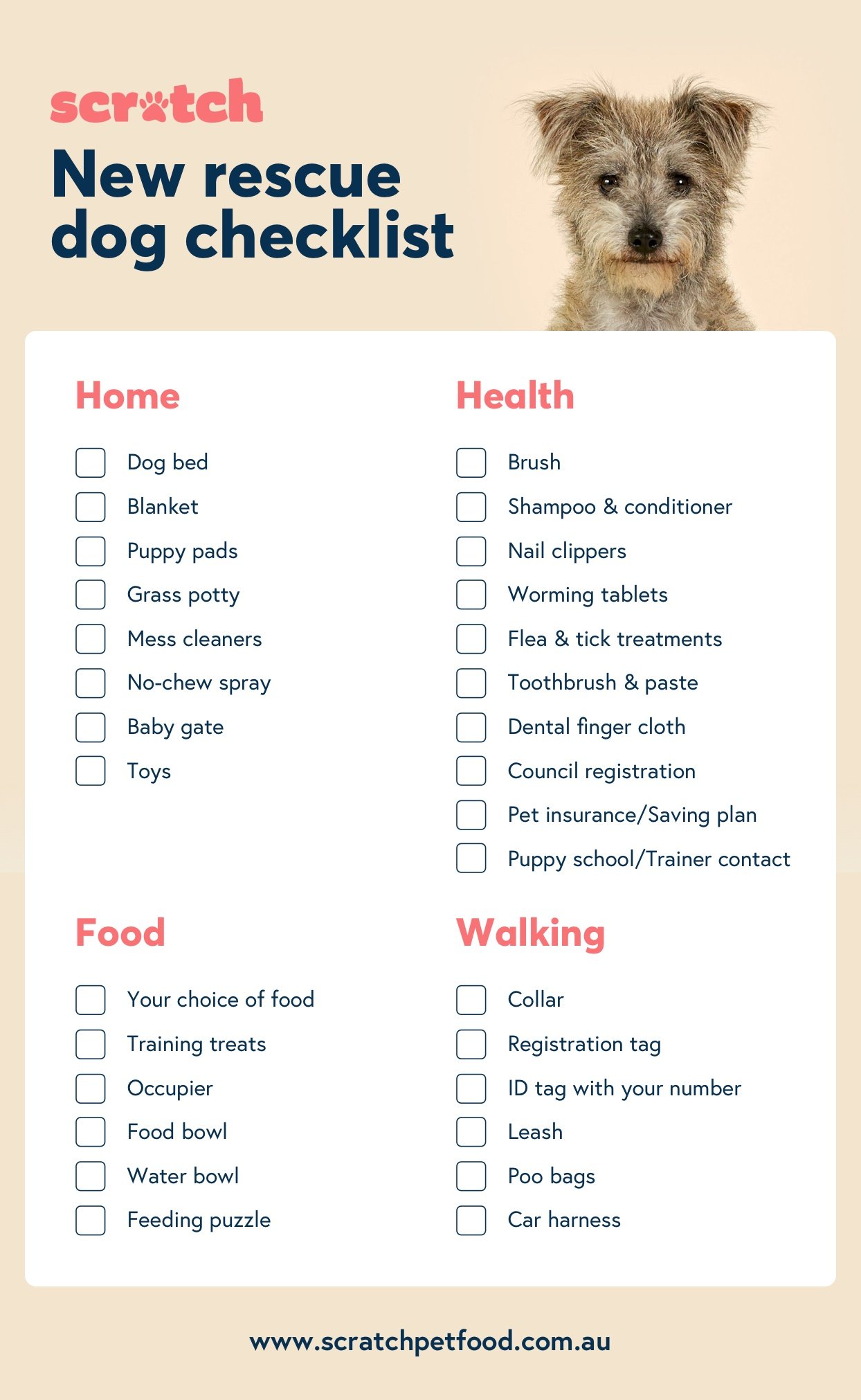
Getting Your Home Ready for a Rescue Dog
With advice from Healthy Dog Pod’s Sophie Allan.
When preparing to adopt a dog, spare a moment (or, maybe a few days) to make sure your house is ready for the new family member. Even older rescue dogs have specific needs that should be anticipated ahead of time. That pot plant, those socks, that power cable might be boring to you, but they could be fascinating to them. So before you bring your new mate home it’s worth taking the time to look around your house from their perspective.

Start by deciding what rooms you’ll allow your dog into. Any space where they’ll be spending time needs to be vetted–including garages and yards. Once you’ve assigned your dog-friendly zones, review them with an eye out for the following items. Any dangerous objects should be removed or placed somewhere out of reach.
Cleaning Products and Medications
Be very conscious of your cleaning products, medications, household poisons (such as weed killer or rat bait), fertilisers, insecticides or paints. Think, would I want to eat that? If the answer is “no way” then store them in a locked cupboard or on a high shelf.
Electrical Cables
Dogs often use their mouths to explore new objects, so be wary of any electrical equipment that could give them a shock if chewed. If you can’t remove them, make sure they’re tied up or taped down.
Blinds or Drapery Cords
Pets can easily become tangled in cords or mistake them for a toy during play. This can lead to injuries or strangulation. So make sure they’re tied back or secured away after use.
Plants
Many popular house and garden plants can be dangerous to dogs if ingested. Look up the plants you have around your home to see if they’re toxic to pets. If so, make sure they’re removed or out of reach
Items on the Floor
Pick up anything that may be small enough for them to swallow. This includes things like shoes, socks, rugs, pillows, homewares and objects with small parts they could gnaw off. Remember, you can’t be too careful. Even soft objects can cause issues.
Rescue dogs experiencing anxiety may express this in destructive ways. Don’t get angry if they damage something that could have been packed away.
Don’t Forget the Garden
All the above watch-outs also apply to outside areas. Make sure any garden, courtyard, or balcony is fenced and secure with no holes where pets could escape. Pool fencing is also a must, along with a pool cover.
Again, an anxious or unsettled dog might take out their energy through digging. Pool or temporary fencing may be needed to keep them away from your prize roses.
Think about Their Sleeping Area
Pay extra attention to where your pet sleeps to make sure it’s safe and secure. Small rooms, crates, and pens are all good options. But wherever you choose, ensure it’s not in a thoroughfare or an area where there is a lot of movement. You don’t want them to be constantly disturbed, tripped over, or stepped on.
Playpen, Crate & Baby gates
If you want to keep your dog away from dangerous areas for a short period of time or when you’re not around (say if you’re doing house work that involves chemicals), consider using a crate or playpen. To make areas of your home permanently pet-free, you can set up a baby gate.
Barriers like this may be handy when trying to introduce a rescue dog to other pets or family members. Allowing them to sniff their new pal through a barrier can help you manage a slow introduction and avoid them becoming overwhelmed.
Keep Things Closed
Doors and cupboards aren’t the only things to keep in mind. Also ensure that washing machine and dryer doors, rubbish bins and toilet lids are all secured too. Trust us, if it’s possible, they’ll find a way to get in.
Alternatively, they may be interested in getting out. Make sure you keep your front and back doors closed, and secure any external gates. It’s not uncommon for a new rescue dog to attempt an escape act.
Child Proof Latches
If you have low cupboards or doors that don’t close securely, and you don’t have time to get them fixed, child proof latches are great as a quick solution.
Bringing a rescue dog home for the first time
With advice from Healthy Dog Pod’s Ian Shivers.
When bringing any dog home for the first time, it’s important to make a good impression. But this is especially vital when rehoming rescue dogs. Depending on the animal, they may be experiencing additional anxiety or stress. You can help ease this with a bit of preparation and by following these 10 steps.
1. Make Sure They’ve Been to the Toilet
Before they enter a new area, take them for a short walk to help avoid accidents.
2. Know What You Want
Consider where they’re going to eat, sleep, and spend time before they arrive. Map out what their average day will look like, as well as what ongoing boundaries you want to establish. All dogs like clarity, consistency and routine, it makes them feel safe.
For example: If you don’t want them to beg at the dinner table, feed them their meals at the same time you’re eating yours. Don’t like them on the bed? Create a space for them that is comfortable, safe and warm, one they would choose to be in over anywhere else. Be consistent and keep it up. Too much free reign, or breaking routines, may set them up to feel overwhelmed and pick up unwanted habits.
3. Have Your Home Set up for Them Before They Arrive
Speaking of consistency and preparation: pre-organise bedding, food, toys and chews, water bowls and some treats so they walk into a steady, calm environment. You don’t want to overwhelm them by moving things around constantly.
Lift up or remove anything you don’t want your dog to have access to BEFORE they come home. If you can’t remove it, then coat it with a chewing deterrent so they learn as early as possible to not put their mouth over it.
4. Know What Associations You Want Them to Have with Each Area of Your Home (and Reinforce Them)
For example: You probably want the living room and bedrooms to be spaces where your pet is relaxed and settled. So avoid leaving toys such as balls and squeakers around, and rather provide bedding and chews in these rooms.
5. Keep Them on Lead
When it’s time to invite them in, play it safe by keeping them leashed. This also goes for any time they’re entering a new space or even meeting new people. It removes the concern that they could bolt out the door or even at another pet.
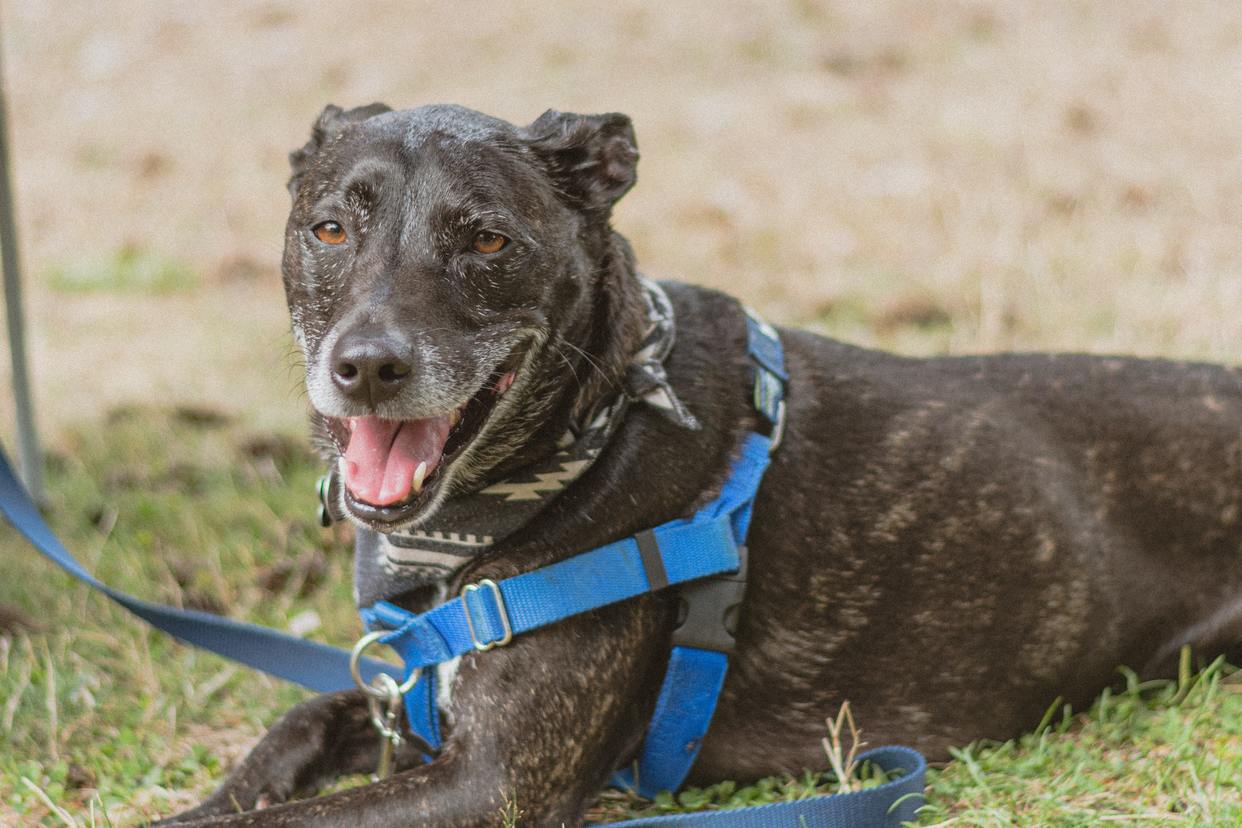
6. Move Slow
Introduce them to the house one room at a time, without anyone else around. Too much too soon can cause them to get overstimulated. The goal is for them to learn calm and positive associations with each space. Let them sniff and explore before removing them to where they are going to sleep or allowing them to rest in the room itself.
7. Take a Break
You don’t have to introduce them to the whole house in one go. Absorbing new information is exhausting. Watch and respond appropriately to your dog’s body language. If they become agitated, distracted, or hyper-aroused it means their mind is racing. Take time to settle things down using gentle encouragement and chews. If you need to pause and come back to the rest of the home later that’s fine.
8. Introduce Family Members One at a Time
Each interaction is a conversation, and it’s easier to focus one-on-one. The same rule goes when introducing them to other animals. Ensure both parties feel comfortable in the environment before trying a face-to-face meeting. Let one pet into a space alone, remove them, then bring in the other. The goal is to let them have a sniff before they meet. They don’t need to be in the same room to start getting acquainted. Again, keeping them on-leash for first interactions may also be a good idea.
9. Positive Experiences Don’t Have to Be Over-stimulating
If your dog is calm, content, and showing no signs of stress, they’re happy. This is a great frame of mind to remember for the home environment. Getting them worked up through play and boisterous interactions may be fun but is it really what you want them to learn about being at home? Nobody has ever called a dog trainer because their dog is too relaxed.
10. Give It Time
It takes roughly three months for a dog to understand that this new space is home. They have strong cyclical memories and remember patterns such as when you get up, go to work, take walks, and feed them. But they need repetition to learn and can be thrown off by changing routines–so be consistent.
Getting ready for the dog park
Dog parks can be a lot of fun for pets and owners. But they can also get very tense, very fast. So before you head down, consider these five things to decide if you’re ready to join the pack.
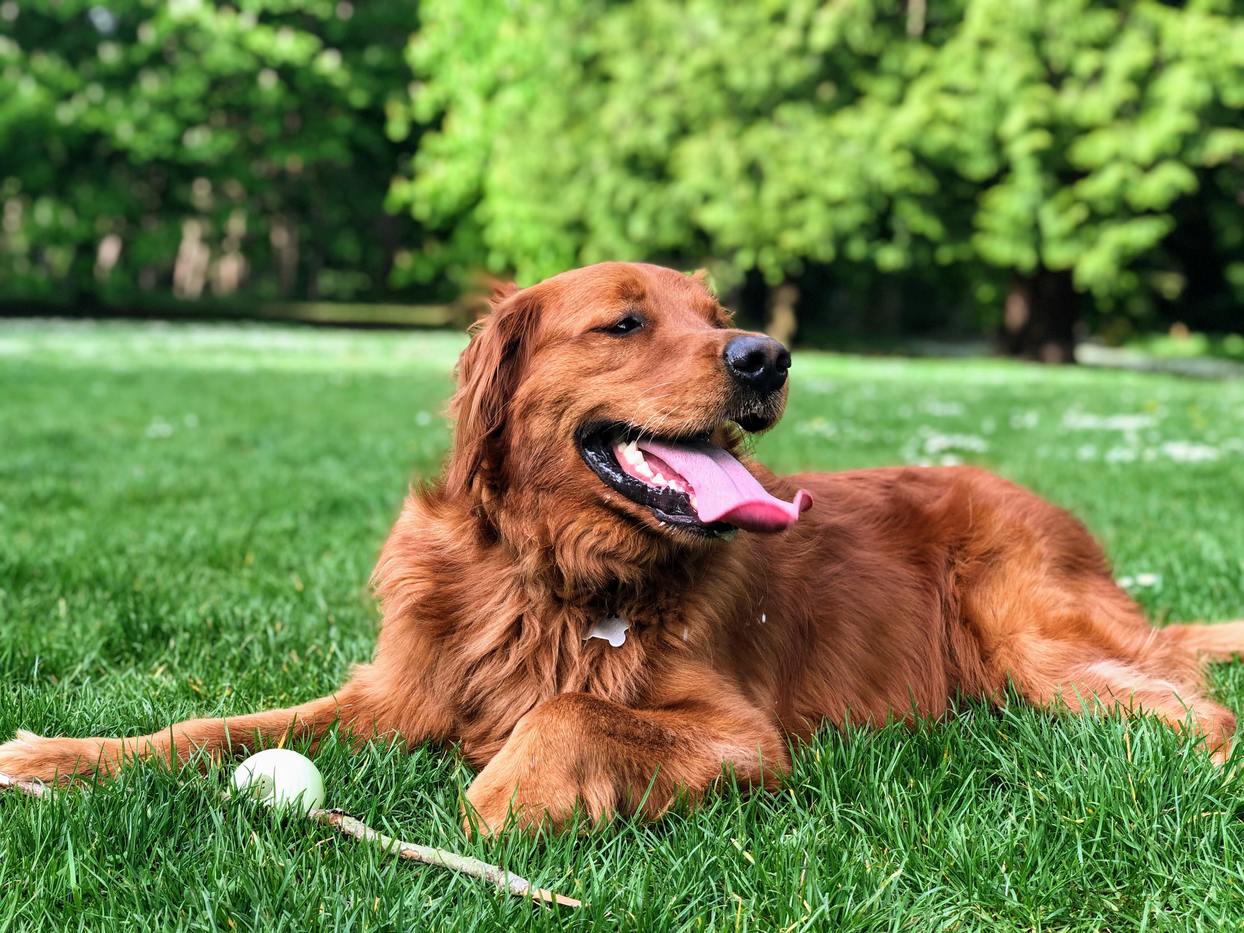
Record Check
Dogs under the age of 16 weeks aren’t ready for the dog park because they may not be finished with their early inoculations and can be vulnerable to disease. But older dogs need to keep their health in mind too. Check that your rescue dog’s vaccination, flea and heart treatment records are up to date. They’ll also need to be dedesexed: dogs that aren’t spayed or neutered can cause issues among the group (not to mention risk unplanned mattings).
Test run
Dog parks can be overwhelming for anyone. But if you have recently adopted a rescue dog it pays to go slow. Try taking them on a walk with another dog you know first. That way you can get a sense of their reaction to other animals in a more controlled environment. If they seem tense, aggressive, or overly anxious give the dog park a miss for now. Focus on behavioural training and helping them feel secure with you first.
Manners Matter
Once you’re sure they’re ready to head to the dog park, read up about the space online or swing by alone first. This will inform you of specific rules ahead of time. For example, are there areas for different sized dogs? Is it an on or off leash space?
In general, pets that don’t have strong recall skills aren’t ready for the dog park. This means they (always) come when you call, no matter what else is going on.
To decrease the chance of them getting overly excited, don’t take them straight to the park. Go on a walk first where they can burn off extra energy so they arrive in a more relaxed state.
Dress Code
All dogs need to wear a collar and tag with their name and your phone number on it. Make sure their registration information is up to date too. Whether it’s an on or off leash park, they should stay leashed as you enter.
Pack a Bag
Remember your poop bags. Many parks provide them, but there’s no guarantee they will be stocked up. Leaving mess behind in a communal dog park is a bad move.
Take toys, but not their favourites. Remember, anything you bring could be damaged or snatched by another dog. You don’t want them to become overly possessive or risk losing a special item.
Treats are a great way to reward your dog for good behaviour, but ask before giving them to other pets. You never know who has allergies or special diets.
Heart to Heart
Ultimately, you’re the one who has the best sense of whether or not your pet is ready for the dog park. Even the sweetest animals in the world can get anxious, overwhelmed, or struggle to properly engage with other pets. Be objective: is your pet going to be a positive presence in this space? Will they make it a good experience for others? If not, that’s ok. It doesn’t mean they’re a bad dog. Just not a dog park dog.
Is Your Rescue Dog Ready for the Dog Park?
Have you looked up the park and its rules? Y / N
Have you checked your dog’s vaccination records are up to date? Y / N
Are their registration details correct and are they wearing a collar tag with your phone number? Y / N
Have you taken them for a walk with another dog to see how they respond to other animals? Y / N
Have then been for a walk or play to burn off extra energy? Y / N
Do you have poo bags, snacks, and (their second favourite) toys? Y / N
Is their recall command strong? Y / N
Do you think other animals will honestly have fun with your dog around? Y / N
If you answered yes to all these questions, lace up your shoes and head out.
If you said no to any of them, you’re not quite ready for the dog park.
Dealing with Rescue Dog Challenges
With advice from Bark in the Park dog trainer Megan Hayes.
There will always be some level of uncertainty around how rescue dogs will act after adoption. Behaviours that frequently only surface post-adoption include: separation anxiety or separation-related behaviour, reactivity towards people or other dogs and resource guarding. While it can take several weeks for a dog to settle in their new home, and several months for the dog to fully adapt to their environment, early intervention to any serious behaviour problems is crucial.

There are three main avenues of support if you’re struggling with your new rescue dog:
Talk to the Shelter or Rescue
Chatting to the adoption staff may provide insight into the cause or motivation behind your dog’s behaviour, as the staff may have seen it too. Knowing the function of problem behaviour is vital in developing an effective plan to work through it.
Contact an Experienced Trainer
Choose a trainer who uses rewards-based training methods to help you communicate with your dog in the most effective and ethical way.
Dog training is an unregulated industry in Australia, so when you begin your search you’ll likely be faced with a plethora of people claiming different qualifications and guaranteeing results. A good tip is to check out what marketing language they use; if you see words like ‘dominance’, ‘pack’, ‘alpha’ or ‘leadership’ it’s likely that person uses punishment-based methods which you want to avoid. The shelter or rescue staff might also recommend a trainer who they work with regularly, but do your own research to make sure you feel comfortable with the techniques the trainer uses.
If your problem is urgent, plenty of trainers are now offering online consultations which can usually be scheduled on short notice and are just as valuable as face-to-face sessions. Plus, the cost is often lower and you won’t be restricted to choosing trainers within your local area.
Consult with Your Veterinarian
If you haven’t done so recently, take your dog to the vet for a general health and wellness check to rule out any underlying pain or illness contributing to problem behaviour. Your general practice vet can conduct a health check, and if you’re after advice relating specifically to your dog’s behaviour you can also seek the help of a vet with qualifications in animal behaviour.
Alongside consulting with your trainer and vet, here are a few things you can do which might help:
- Provide an opportunity to “decompress”: Allow your dog to experience life in the absence of any stressors, even if they are only minor. Avoid long walks, café trips, dog park visits and introducing new things/people. The goal is to keep your dog’s environment as calm as possible so their physiological systems can recover.
- Set up a predictable routine: Dogs feel comfortable when they know what to expect in regard to social interactions, attention and general day to day activities. Dogs who have an inconsistent, unpredictable routine and a lack of control over their environment are more likely to show anxiety and fear related behaviours.
- Let them sniff: Sniffing is a great source of mental exercise for dogs and can be highly therapeutic for those who are easily stressed. Let your dog follow their nose out on walks or try some treasure hunts with treats in the backyard.
- Provide a safe space: Make sure your dog has the opportunity to socially distance themselves whenever they need! A safe space could be a crate, kennel or corner of the room where no humans (especially kids) are allowed to touch or interact with the dog.
Remember, It’s Not Your Fault
Even if a dog has no prior history of mistreatment, was well-cared for in the shelter and has been placed in a great home, there’s still a chance that serious behaviour problems can emerge. Causes of anxious, fearful and aggressive behaviours are usually complex and multifaceted – these problems are definitely not a reflection on you or your ability to raise a dog.
Teaching your dog new coping strategies and helping them work through their fears can be time-consuming and emotionally draining, but seeing progress in the process makes it all worth it. However, you should consider what your dog needs in terms of support and weigh this up against what you can realistically offer. If you don’t have the resources (consider time, money and mental resilience) to provide proper assistance, the best decision for the welfare of the dog may be to return it to the shelter or rescue. While this can be a really difficult choice to make it might mean the dog has a better chance at a happier and stress-free life.
That’s all folks. Enjoy the journey!
A huge thanks to our contributors in this guide to dog rescue:
Megan Hayes
 Megan Hayes is a dog trainer at Bark in the Park and a PhD candidate at the University of Melbourne’s Animal Welfare Science Centre.
Megan Hayes is a dog trainer at Bark in the Park and a PhD candidate at the University of Melbourne’s Animal Welfare Science Centre.
Sophie Allan
 Sophie is the Founder of So Help Me Dog and one half of the Healthy Dog Pod. She has always had a passion to work with animals especially dogs ever since she was little wanting to be a vet. Working at the customs breeding facility in reignited her study again when moving to Sydney in 2013.
Sophie is the Founder of So Help Me Dog and one half of the Healthy Dog Pod. She has always had a passion to work with animals especially dogs ever since she was little wanting to be a vet. Working at the customs breeding facility in reignited her study again when moving to Sydney in 2013.
Ian Shivers
 Ian Shivers founded Bondi Behaviourist in 2015 and is the other half of Healthy Dog Pod. Having worked within rescue organisations and doing one on one consultations since 2007 in England and Australia, Ian has a wealth of experience. His passion is to create a platform for which information on dog behaviour and training can be shared to improve the quality of life for both dogs and dog owners alike.
Ian Shivers founded Bondi Behaviourist in 2015 and is the other half of Healthy Dog Pod. Having worked within rescue organisations and doing one on one consultations since 2007 in England and Australia, Ian has a wealth of experience. His passion is to create a platform for which information on dog behaviour and training can be shared to improve the quality of life for both dogs and dog owners alike.
For more useful dog advice, learn from our guides to plants safe for dogs, dog-friendly offices and getting a rescue dog.